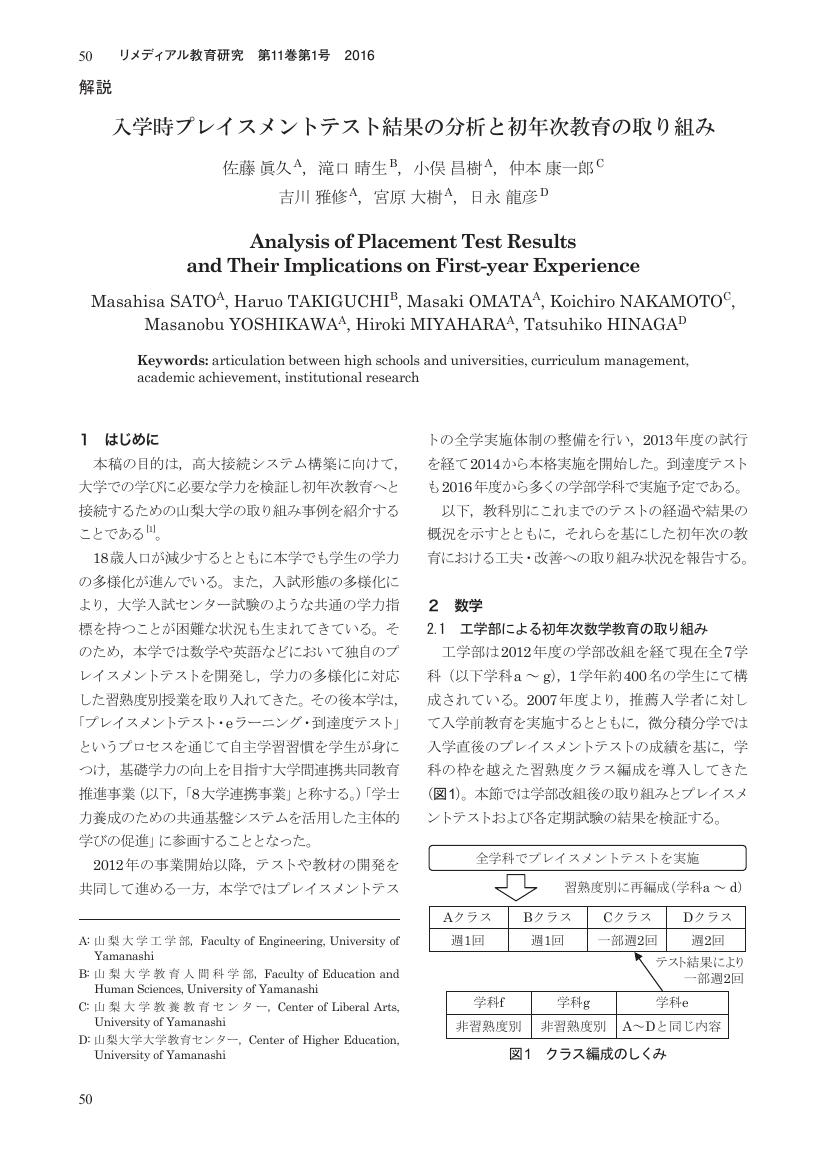- 著者
- 日永 龍彦
- 出版者
- 一般社団法人 日本教育学会
- 雑誌
- 日本教育学会大會研究発表要項 (ISSN:2433071X)
- 巻号頁・発行日
- vol.69, pp.118-119, 2010-08-13 (Released:2018-04-20)
2 0 0 0 OA 高等教育における独立性の変容とその課題(<特集>教育経営の独立性を問う)
- 著者
- 日永 龍彦
- 出版者
- 日本教育経営学会
- 雑誌
- 日本教育経営学会紀要 (ISSN:02872870)
- 巻号頁・発行日
- vol.57, pp.40-50, 2015-06-15 (Released:2017-07-06)
- 被引用文献数
- 2
This study traces the process of the establishment and transformation of university autonomy in Japan. The concept of autonomy is defined by the combination of self-governance and self-government. This study focuses on the latter, especially self-government against the power of the state, because the state has repeatedly tried to intervene in university autonomy since the Meiji era. In order to trace this process, the author divided these approximately 150 years into three periods. The first is from the beginning of the Meiji era to 1952. In this period the modern universities were established, autonomy was gradually forming as a custom before World War II, and the bureaucratic control of universities so far was eliminated after the war. The second is from the end of the occupation by the Allied Powers to the end of the 20th century. In this period the government colluded with industry to try classifying the universities into several types of higher education institutions, but they were finally forced to abandon this attempt and leave the universities to diversify themselves. The government also had to abandon the higher education policy of strictly regulating the numbers of universities and students because the number of children was rapidly declining. The last period is from the start of this century to the present. In this period the Prime Minister led deregulation and used evaluation as a tool for allocating financial resources to universities. At the start of university evaluation, the government clearly stated considering university autonomy and regarded the mission and objectives of each institution as evaluation standards. Recently the government has intensified intervening in the missions and objectives of the universities and is forcing university classification, making a distinction in financial support among the universities.
2 0 0 0 OA 大学評価政策の展開と大学の自治
- 著者
- 日永 龍彦
- 出版者
- 日本教育行政学会
- 雑誌
- 日本教育行政学会年報 (ISSN:09198393)
- 巻号頁・発行日
- vol.40, pp.17-35, 2014 (Released:2019-03-20)
- 参考文献数
- 8
The purpose of this study is to trace the process of “the university evaluation” changing from the self-improvement oriented to the guided or forced reform oriented in these 40 years. The study shows that university evaluation for self-improvement remains only in name and that the evaluation is used for standardizing universities without considering university autonomy. In order to prove this, the author divided these years into three periods as follows: ⒜ the 1970s and 1980s, in which “the convoy system” for colleges and universities was in place. However some people in the university bodies and in government realized that the system could not continue just before the rapid decrease in the population of 18 year olds. ⒝ the 1990s, in which the university evaluation system was set up by the ministerial ordinance of the Ministry of Education. Not colleges and universities themselves but the Ministry of Education took the lead in establishing this system. ⒞ the 2000s and later, in which the Prime Minister led the deregulation and used university evaluation as a basis for allocating financial resources.In the first period ⒜, some university bodies tried to develop a self improvement-oriented evaluation system. Although they seemed to find it very difficult for university evaluation to seek improvement and accountability at the same time, “Rinji kyoiku shingikai”, an advisory panel to the Prime Minister established in 1984, did not take this issue seriously. Its Final report simply listed both improvement and accountability as functions of university evaluation. this appeared to be a factor in the failure of university evaluation in Japan. University evaluation has not worked well either for improving universities or for providing useful information to the public since then.In the second period ⒝, the age of rapid decrease in the population of 18 year olds caused almost all the universities had to face a struggle in enrolling students. the Ministry of Education deregulated the university establishment and reorganization in order to cope with the situation. Universities were obliged by the ordinance, university establishment standard, to work on self-education at the same time. Evaluation for selfimprovement ought to be voluntary, but universities were reluctantly engaged in the self-education in order to obtain authorization for the reorganization, a kind of self-improvement, from the Ministry of Education.In the final period ⒞, the “Amendment of School Education” law set up a third party evaluation system for universities, “Ninsho-hyoka”. In addition, national universities were incorporated and the evaluation system for national university incorporation was introduced. The original plans of these evaluation systems were based on the mission and objectives of universities, that is the evaluation to respect the individuality of each university. But those plans were changed 6 or 7 years after being introduced. Some measures were carried out to standardize the mission and objectives of each university. Moreover, the government has often used this evaluation for financial resource allocation in recent years. The indices used in the evaluation force universities to improve or reform universities in the same direction.
1 0 0 0 OA 山梨大学のデータサイエンス・AI教材の開発経過と今後の展開
- 著者
- 鈴木 一克 塙 雅典 森澤 正之 日永 龍彦 鈴木 裕 佐藤 友香
- 出版者
- 日本リメディアル教育学会
- 雑誌
- リメディアル教育研究 (ISSN:18810470)
- 巻号頁・発行日
- vol.16, pp.127-136, 2022-07-01 (Released:2022-08-20)
- 参考文献数
- 9
政府は,AI戦略2019において,2025年度までに全国の大学・短大・高専の文理を問わずすべての卒業者がデータサイエンスの素養を身に付けるということを達成目標のひとつとして掲げている。データサイエンスは比較的新しい分野であることから,学習用教材の整備が全国的に進められている。本稿では,山梨大学における数理・データサイエンス・AI教育のための教材開発について解説する。山梨大学では,データサイエンス科目で修得すべき知識と技能をまとめたリファレンスを作成し,全学部入学者に対してリテラシーレベルのデータサイエンス科目を必修化した。授業実施にあたり,授業シラバスを作成するとともに教育用教材を設計・開発した。当該教材は,講義動画およびパソコン演習実演動画の2種類から成り,文系・理系を問わず,学生の事前知識や習熟度,授業の目的,または授業を補完するためのリメディアル教育等,必要に応じて教材の必要な箇所のみを学習に利用可能である。本稿ではまた,教材の学外公開等,今後の展開についても述べる。
1 0 0 0 OA 戦後新制大学の質の維持・向上システムの再検証 -改革モデルの選択・理解・受容-
1940年代の米国では、民間の大学・学校協会よりも州立大学や州政府がアクレディテーションを行なう件数が多く、それが占領側の指導内容に影響していた。これは、戦後改革期の大学設置認可とアクレディテーションの制度を「特殊日本的」と見てきた先行研究の見直しを迫るものである。また、米軍統治下の琉球では、日本本土で頓挫した大学設置認可や大学管理制度が実現していて、それが琉球の人々の選択の結果であったことを明らかにした。さらに、ランドグラント大学をモデルとする琉球大学では、本土と異なり、家政学の教授陣による普及事業が推進され、米国のカリキュラムがそのまま移入されたことなどを明らかにした。
1 0 0 0 OA 入学時プレイスメントテスト結果の分析と初年次教育の取り組み
- 著者
- 佐藤 眞久 滝口 晴生 小俣 昌樹 仲本 康一郎 吉川 雅修 宮原 大樹 日永 龍彦
- 出版者
- 日本リメディアル教育学会
- 雑誌
- リメディアル教育研究 (ISSN:18810470)
- 巻号頁・発行日
- vol.11, no.1, pp.50-58, 2016-03-31 (Released:2017-02-08)
- 参考文献数
- 3

